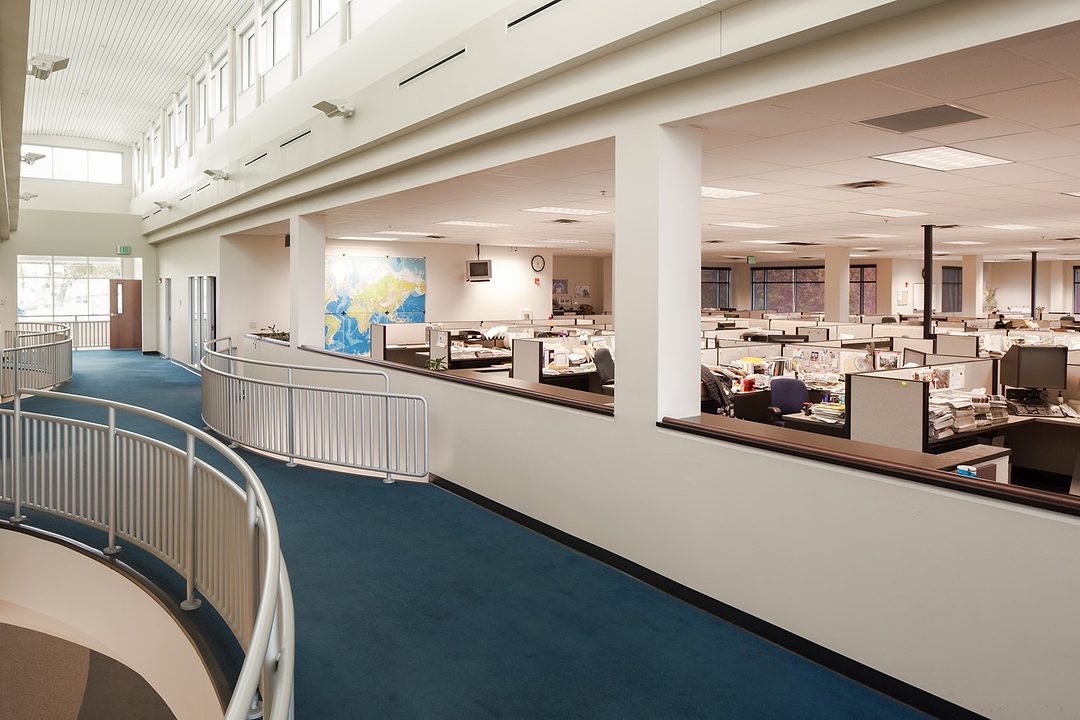
Home » Downtown changes coming with sale of Herald building
Downtown changes coming with sale of Herald building

November 14, 2019
It took almost eight years and a lot of on-again, off-again negotiations with different prospective buyers, but the Tri-City Herald building in downtown Kennewick has new owners.
Pasco investors Mike Detrick Sr., his son Mike Detrick Jr. and their wives bought the building at 333 W. Canal Drive for $3.9 million in October with plans to transform it into multi-tenant office space.
The Tri-City Herald will remain a tenant—for now—but it has plans to move elsewhere after spending 71 years there.
“I think it’s a good thing for us,” said Jerry Hug, the Herald’s general manager. “We’ve been trying to sell the building on and off since 2011.”
Hug said when the building went on the market, they expected it could take a few years to find the right buyer.
“We’ve been close a couple of times, but then it fell apart. That’s the way these large sales happen,” Hug said.
The Herald no longer needs such a big building. It has 45,000 square feet of office and 57,000 square feet of industrial space. The McClatchy Co., the Herald’s California-based parent company, invested more than $9 million to build the new building and renovate the production facilities in 2004.
New owners, new plans
The Detrick family has the experience to develop the property. It already owns smaller apartment complexes in Kennewick and Richland and a multi-tenant office building in Kennewick, and is building an office in an industrial park in the south Richland area.
Mike Detrick Jr. owns D9 Contractors, a commercial drywall business that has already begun moving into the former press, newsprint storage and circulation areas.
The company will store its construction equipment and supplies there.
“We’re doing so as we speak,” Mike Detrick Sr. said.
The Detricks felt it was the right time to buy.
“It’s just a good business opportunity,” Detrick Sr. said. “We’ve been in the works on this for about four or five months. The price was originally higher. But when it came down, we decided to do it.”
The family bought the property under the name, 7D Development at Herald Building LLC.
Detrick Sr. said they also are working to secure and portion off the area the Tri-City Herald now is leasing.
Then it will be time to start dividing up the rest of the building.
“Obviously the building is designed for a newspaper situation, and we’ve talked a lot as to how it could be demised,” Detrick Sr. said.
To that end, he said, it’s pretty clean the way it was built. “I think we could put in anywhere from one or two, to six or seven new businesses, as related to the office space,” Detrick Sr. said.
He said he’s leaning on real estate broker and senior advisor Scott Sautell of SVN Retter & Co. in Kennewick to lead the charge to find businesses interested in leasing space there.
Sautell, who brokered the building sale, said the building easily could accommodate more businesses.
“You could probably put as many as six businesses in at a minimum, and possibly as many as 12. It depends on how much you demise it,” Sautell said.
The hallways dividing the building —which once were called the Company Street when the Herald first moved in— run north and south on the first and second floors.
“There are bathrooms that are right off the hallway on both floors,” Sautell said. “It’s really the perfect setup. It’s one of the few, probably only, class A building in the downtown district.”
A class A designation is considered premier space in high-quality buildings.
Asked if a restaurant or two could be added, Sautell said yes. “It could be done. It just takes money,” he said.
Think of the Herald building as a blank canvas, Sautell said.
How the building gets carved up remains to be seen.
“The possibilities are endless for those businesses that want to get in first,” Sautell said. “The main thing they want is credit-worthy tenants.”
But the right people to help set up the different business and office space are already in the building, he said.
“The owners are in the drywall and framing business,” Sautell said. “What better guys to break this up? They’re good guys and very well-rounded landlords. I’ve been working with them for years on real estate deals and they are always seamless.”

What about the Herald?
The Tri-City Herald has a lease with the new owners for the next 10 months and plans to move elsewhere after it’s up in 2020, Hug said.
That’s a big change for the newspaper that’s called downtown Kennewick home for 71 years—though it wasn’t always there.
The Herald moved from Pasco to Kennewick in October 1948, taking over the site of the bankrupt K&P Cannery, according to a Herald timeline once displayed on the second-floor walls. Built in 1906, the old cannery building became the cornerstone for many expansions and remodels. It made up the northeast corner of the newspaper building, serving as the front lobby for several decades. In 2004, it was converted to a loading dock.
The 8,000 square feet the Herald is occupying now still is too much space, Hug said.
Hug has been searching for the right building to move the team into. He said he’s not looking to build a new building, but instead find an existing, available one.
“We’re trying to get into a smaller footprint,” he said. “We’ve been looking around for a year, trying to find the right place. We need to find a high-traffic area. But we’ll definitely do some type of storefront so that customers can come in.”
When the Herald opened the new building 15 years ago, it was close to capacity. The building at full occupancy can accommodate up to 175 employees. Today’s current staffing levels are much smaller.
Like many other newspapers nationwide, the Tri-City Herald stopped printing its own paper as a cost-saving measure in 2012, striking a deal with the Yakima Herald-Republic, owned by The Seattle Times Co., to use its printing press.
The Herald’s $6 million press, bought in 1992, took up two floors and the warehouse housed 1-ton rolls of newsprint that stretched to six miles when unrolled. In its heyday, at least eight rolls were used each day, according to Herald building tour information.
With the press closure and subsequent staff downsizing, the 102,000-square-foot building is no longer necessary, especially as the Herald’s focus switched from print to digital.
“Times have changed,” Hug said.
It’s not a situation unique to the Herald. Daily newspapers nationwide have been on a decline for about a decade amid dwindling advertising revenue and subscriptions in a world where more people consume information online via smartphones.
The Tri-City Herald has continued to tighten its belt. It ceased printing on Saturdays on Nov. 9. Back in 1981, it had trumpeted the addition of its first Saturday edition to become a true seven-day daily.
“I understand the frustration of those who want the physical newspaper. We’re making tough decisions to ensure our future. Media, like retail and other industries, has changed significantly in recent years. Our advertising model has been upended by the digital world.
“And our continued digital conversion is going to be critical to our future ability to offer local journalism,” Executive Editor Laurie Williams wrote in a recent column about the changes.
Hug said the Herald and its staff will continue to work hard to provide local news coverage as the company navigates through tough economic times in the industry.
“We’ve tried to repurpose ourselves, and we’ve gone through a lot of iterations,” Hug said. “We’ve done that so that we can continue to be the best news source in the region.”
Preserving history
Newspapers have long been considered the first draft of history and an important tool for those researching the past.
One of the big concerns during the building sale negotiations was what to do with all of the bound newspaper volumes, which are stored upstairs in a windowless, climate-controlled room called the morgue.
“There is a lot of history here,” Hug said. “There are mountains and mountains of records here that date back 40, 60 years, even longer. There is stuff that is historical, like a walk down memory lane.”
The Tri-City Herald was created in 1947 when three businessmen purchased the weekly Pasco Herald from Bill Wilmont, according to the Herald timeline. The team of Glenn C. Lee, Bob Philip and Hugh Scott planned to create a daily newspaper to serve the entire region. Scott, the veteran newspaperman in the group, was named the first publisher. Readers submitted potential names for the new daily, with several providing the winner: Tri-City Herald.
Bound volumes of the Pasco Herald can be found in the Herald archives.
“D9, as part of the sale, will hold the bound volumes, and for the next 10 years we have access to it,” Hug said.
That was a big concern for Hug and other community historians.
“When we first started to try to sell the place, I talked to a number of archive facilities in the region about holding these volumes,” Hug said.
Everyone was interested, “until you see the grandeur of it all,” Hug said.
Downtown changes
Hug is interested to see what the Detricks do with the building.
“We’ve been a cornerstone in downtown for years,” Hug said. “Everybody is worried about downtown. You want business down here, and you want to keep it flourishing.”
He believes the Detricks are the right people to keep that going.
And Detrick Sr. likes what he sees going on downtown, including a new, five-story building a few blocks away that will have two stories for retail and three stories of condominiums.
“It’s great. There are some new businesses, and several renovations in downtown Kennewick right now,” Detrick Sr. said.
Sautell agreed: “The Herald building project is going to be great for downtown.”
Local News
KEYWORDS november 2019




